Vincent Van Gogh signed his paintings in many different ways. It is good to understand exactly how and where he signed his paintings.
Vincent Van Gogh usually signed his paintings simply ”Vincent” with a line under his name. Sometimes he would add a date and an inscription if the painting was for a friend. Vincent Van Gogh usually signed his paintings on the left-hand side, but other times he signed his name on an object in the painting.
Table of Contents
- Van Gogh Signed His Paintings As “Vincent”
- Different Ways That Vincent Van Gogh Signed His Paintings
- How Vincent Van Gogh’s Signature Is Authenticated
- 10 Reasons Why Vincent van Gogh Remains an Enduring and Significant Artist
- Frequently Asked Questions
- Related Questions
Van Gogh Signed His Paintings As “Vincent”
Vincent Van Gogh did not sign his painting as Van Gogh but simply Vincent. The fact he used the name Vincent is interesting as today, so many people call him merely”Van Gogh.”
One of the reasons that Vincent Van Gogh signed his paintings simply ”Vincent” was that he had made his home in France; in fact, many of the letters he wrote to his siblings were also in French, although that was not their native language.
He signed his paintings as ”Vincent” as he felt that using his Dutch last name of ”Van Gogh” may be too difficult for French speakers to pronounce.
We also know from the many letters he wrote to his brother Theo that he always ended his letters ”tout a toi, Vincent,” which means ”forever yours Vincent.” His signature on those letters also had a line under his name.
Van Gogh And His Painting Signatures
Like many other things to do with Vincent Van Gogh, there is no set way or method as to how he signed his paintings.
What is interesting about his paintings is that today most artists will sign their paintings on the righthand side of the painting, but Vincent Van Gogh signed his painting on the lefthand side.
But even the lefthand signature rule to Vincent Van Gogh is not always the case as sometimes he changed the rule; he would place his signature on an object or part of the panting.
He often emphasized the letter ”V” more heavily than the other letters on his signature. When you look at his signature, you can see that the V, especially the first stroke of the V, was heavier than the other letters.
Different Ways That Vincent Van Gogh Signed His Paintings
Vincent Van Gogh signs his paintings in so many different ways. He was known to sign them in various locations and methods.
Here are some of the different ways that Vincent Van Gogh signed his works of art:
- Name Vincent And Line – He would often sign his work of art as simply Vincent. That name, Vincent, would have a line under it. An example would be the Impasse des Deux Freres he painted in 1887.
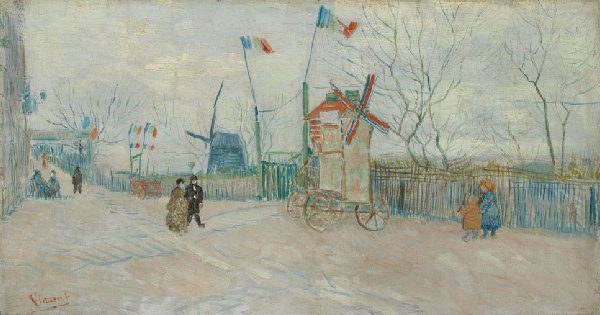
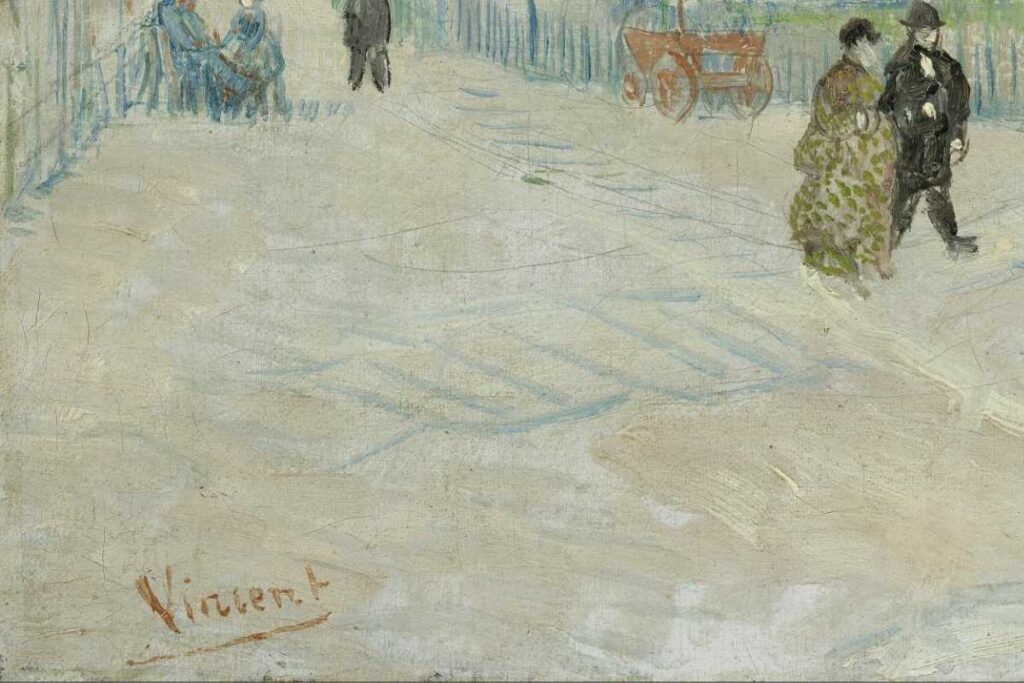
- Name Vincent, Date, And Line – Sometimes, he would sign his painting Vincent and then put a date next to it and a line underneath. The date would usually be 87 and not 1887. An example of this signature is the Vincent Van Gogh Sunflowers, 1887. Sometimes the date would be on the side of the signature, but even this rule changed.
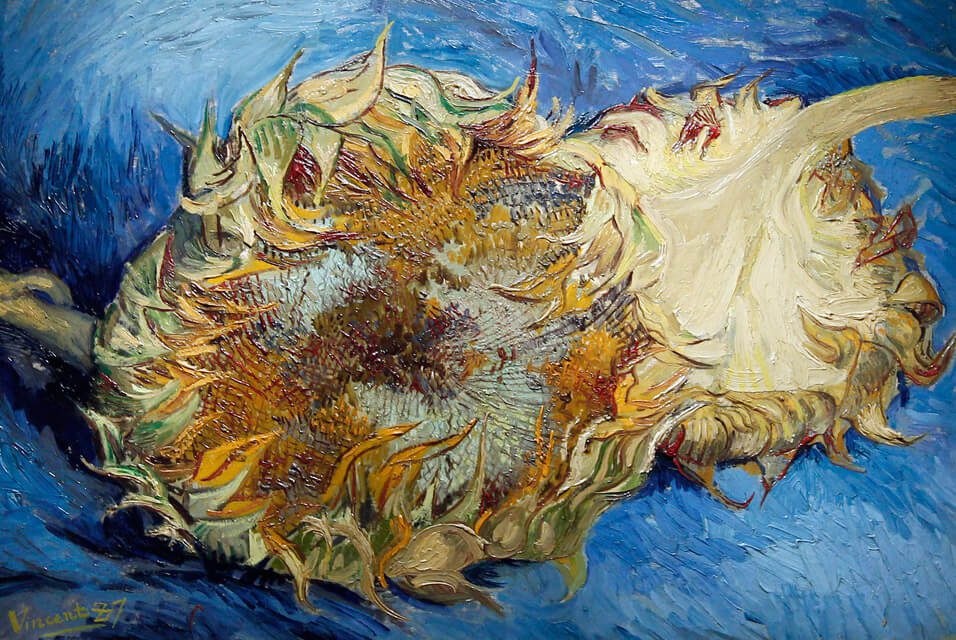

- Inscribed, Name, And Line – Sometimes, Vincent Van Gogh would inscribe on his paintings, mainly if he exchanged a painting with another artist or friend. An example of this is the Basket of Apples he painted in 1887. He wrote on the painting in French,” to my friend Lucien Pissarro,” and then put his name with his signature line under his name.
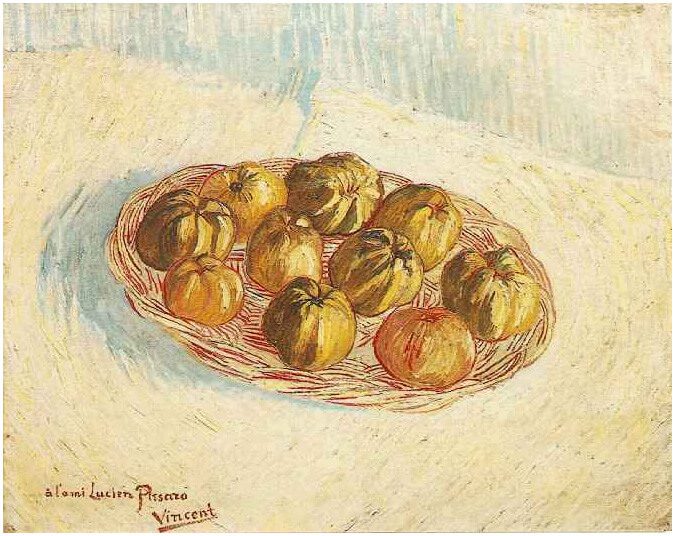
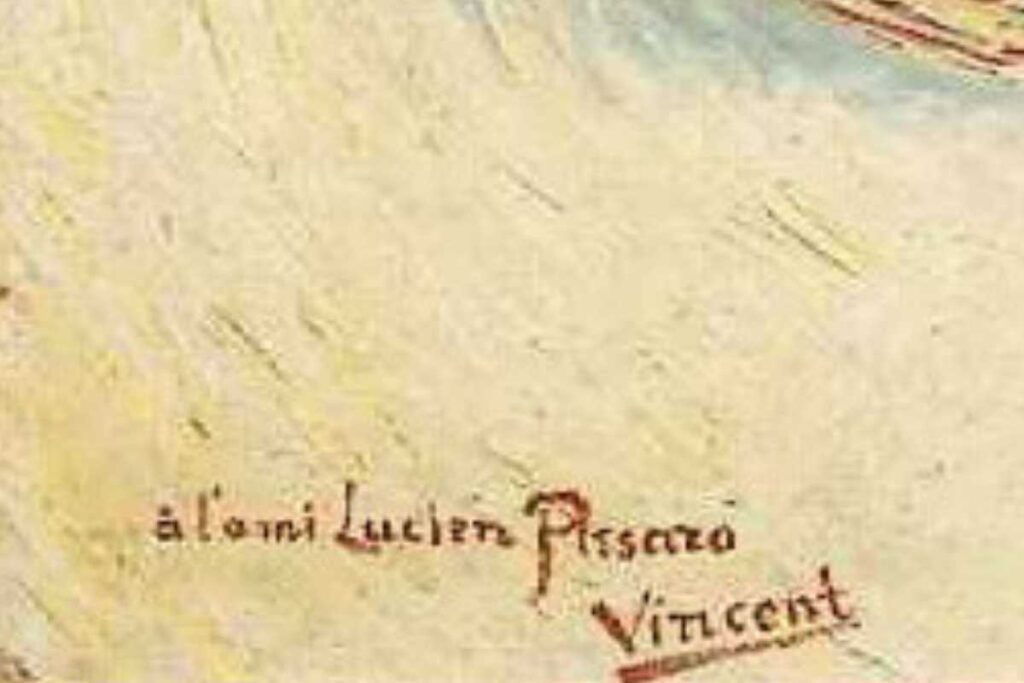
- Signature On An Object In The Painting – Sometimes, Vincent Van Gogh would put his signature on an object in the painting itself. An example of this is the painting by Vincent Van Gogh called “Self-Portrait – 1887.” In this painting, he painted a picture of himself painting and put his signature on the right-hand side of the canvas with his name line and date under the signature.
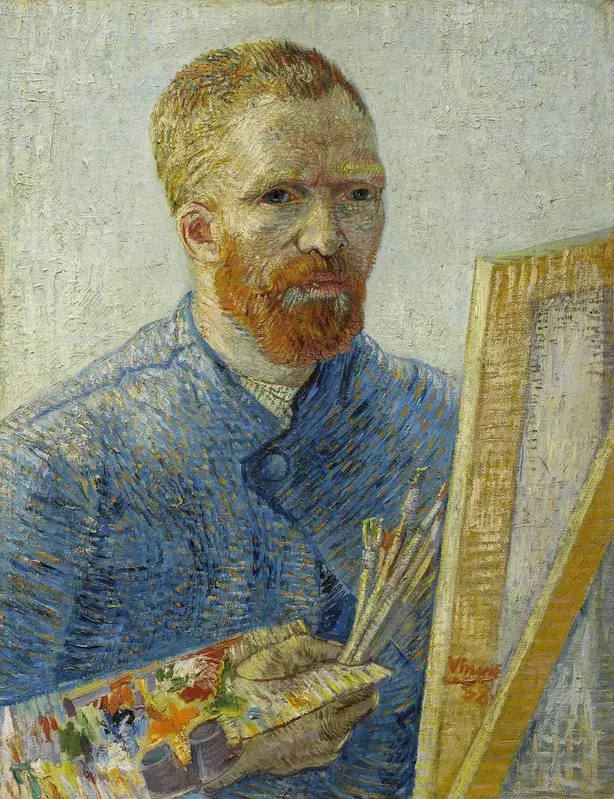
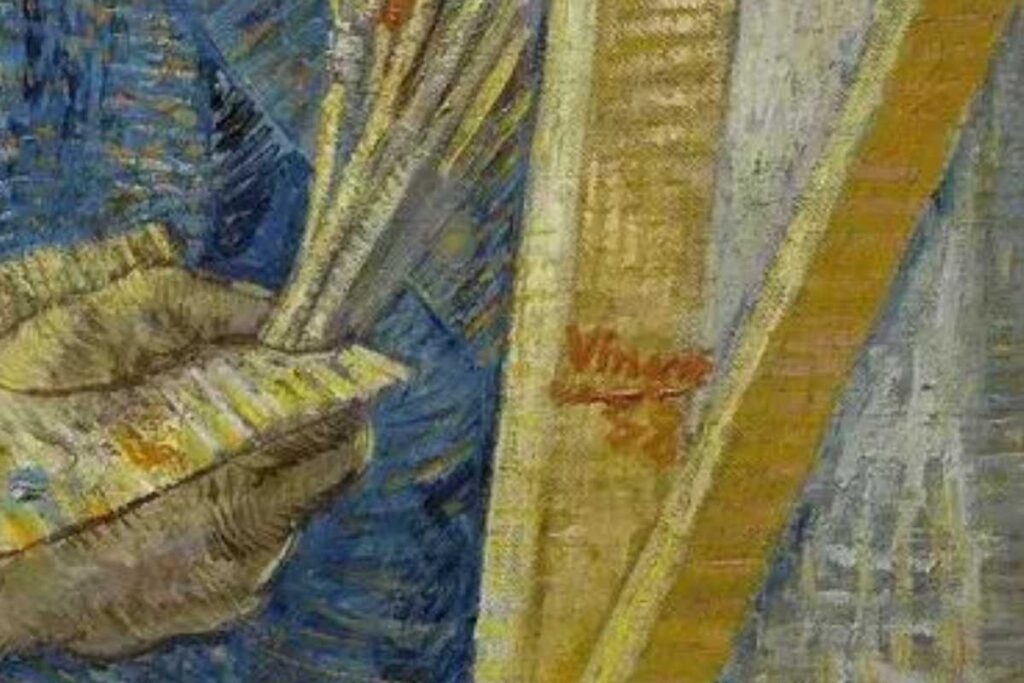
How Vincent Van Gogh’s Signature Is Authenticated
If a Vincent Van Gogh painting is looking to be authenticated, one of the areas that the experts will look at is the signature. To authenticate a Vincent Van Gogh painting does take expert knowledge.
As we have already mentioned, there are so many various ways that today’s authenticators will check to authenticate Vincent van Gogh’s paintings.
Here are some of the ways authenticators may use to authenticate the signature on a Van Gogh painting:
- Check Against Other Paintings – The authenticators will look at the signature on a painting to the largest possible pool of authenticated signatures.
- Look For Patterns – They will then look for similar patterns to ensure that the signature matches other Vincent Van Gogh signature patterns they know.
- Look At The Signature Application – They will also look at the signature application to ensure the Vincent Van Gogh signature is applied by hand with paints and brushes.
- Compared To Other Vincent Van Gogh Signatures – As Vincent Van Gogh was known to write more than 2,000 letters, many signatures can be used to compare to see if the signature on a painting is authentic.
Like many things about the great artist Vincent van Gogh, there is no one hard and fast rule about where or how he signed his paintings.
The most common denominator is that he did sign his paintings as Vincent with a line underneath his name. This is the same way he signed many of the letters he wrote.
10 Reasons Why Vincent van Gogh Remains an Enduring and Significant Artist
Vincent van Gogh, a name synonymous with post-impressionism and passionate artistry, has left an indelible mark on the art world. Even today, more than a century after his passing, his influence and significance are undiminished.
Here are ten reasons why van Gogh’s legacy continues to resonate powerfully:
- Emotionally Charged Work: Van Gogh’s canvases are imbued with raw emotion. Every brushstroke, color choice, and composition reflects his personal struggles, joys, and perceptions, making his works deeply relatable and evocative.
- Innovative Techniques: He introduced a unique style of thick, dynamic brushstrokes—often termed “impasto”—that added texture and movement to his paintings. This technique makes his works instantly recognizable and has inspired countless artists.
- Vibrant Use of Color: Van Gogh had a remarkable ability to convey mood and emotion. His bold and sometimes unconventional color choices, from the vivid yellows of “Sunflowers” to the deep blues of “Starry Night”, have made his paintings iconic.
- Varied Subjects: His oeuvre includes everything from serene landscapes and night skies to intense self-portraits and still lifes. This diversity showcases his ability to find beauty and significance in both the mundane and the profound.
- Personal and Intimate: Van Gogh’s letters, especially those to his brother Theo, offer deep insights into his thoughts, making his work even more personal. These letters allow us to understand the man behind the masterpieces, adding layers of depth to his paintings.
- Evolution of Style: Van Gogh’s style evolved dramatically over a relatively short career, reflecting his personal growth and experimentation. This evolution, visible in his artworks, is a testament to his relentless pursuit of artistic expression.
- Influence on Modern Art: Van Gogh is often hailed as a precursor to modern art. His departure from realism and his embrace of bold colors and expressive techniques paved the way for subsequent art movements like Fauvism and Expressionism.
- Global Recognition and Appeal: From the Van Gogh Museum in Amsterdam to exhibitions worldwide, his works draw millions of visitors. The universal appeal of his art transcends cultural and geographical boundaries.
- Triumph Over Adversity: Van Gogh’s struggles with mental health and his unwavering dedication to art resonate with many. His life story is a testament to the human spirit’s resilience, making him an inspiration both as an artist and a person.
- Enduring Mystery: The circumstances of his life, including his tragic end, have led to numerous discussions, studies, and speculations. This aura of mystery surrounding van Gogh adds to the public’s enduring fascination with him.
Vincent van Gogh is not just an artist but a phenomenon. His ability to touch the soul through his canvases and his personal narrative of passion and pain ensures that he remains a luminary in the vast expanse of art history.
Anita Louise Art is dedicated to art education, great artists, and inspiring others to find and create their art. We love art that uplifts and inspires. #ArtToMakeYouSmile! #ArtToMakeYouHappy!
If you are interested in seeing any of my art, you can find out more by clicking here. If you are interested in what inspires me and my paintings, you can discover more by clicking here.
We have a free newsletter and would love you to be part of our community; you can subscribe to the newsletter by clicking here. If you have any questions, I would be happy to talk to you. You can reach me, Anita, by clicking here.
Subscribe to our Anita Louise Art YouTube Channel with great videos and information by clicking here.
Join us for our podcast “5 Minutes With Art.” Spend just 5 minutes a week with us to discover and learn about great art and artists. You can find out more about our podcast by clicking here.
Frequently Asked Questions
Did Vincent Van Gogh always sign his paintings as “Vincent”?
Yes, Vincent Van Gogh typically signed his paintings simply as “Vincent” with a line under his name.
Did Van Gogh ever include a date on his signed paintings?
Yes, Van Gogh occasionally added a date to his signature, particularly if the painting was intended as a gift or was meant for a specific recipient.
Why did Van Gogh sometimes include an inscription along with his signature?
Van Gogh would add inscriptions to his signed paintings when they were intended for friends or had personal significance. These inscriptions often included heartfelt messages or dedications.
Where did Van Gogh usually place his signature on his paintings?
Van Gogh typically signed his paintings on the left-hand side, either at the bottom or in the lower corner. This placement was a common practice among artists of that time.
Did Van Gogh ever sign his name on an object within the painting?
Yes, at times Van Gogh signed his name on an object within the painting itself. This approach added a unique and personal touch to the artwork.
Did Van Gogh’s signature evolve or change over time?
Van Gogh’s signature did not significantly change over time. He maintained a consistent style of signing his paintings, often using a distinctive cursive script.
Are Van Gogh’s signed paintings more valuable or sought after?
Van Gogh’s signed paintings are highly valued and sought after by collectors and art enthusiasts. His signature adds authenticity and historical significance to the artwork, enhancing its desirability.
Did Van Gogh sign all of his paintings?
While it is believed that Van Gogh signed the majority of his paintings, there are a few instances where his signature is absent. Some early works may not bear his signature, and there are a few disputed attributions in Van Gogh’s oeuvre.
Related Questions
What Art Tools Did Vincent Van Gogh Use?
Vincent Van Gogh used most of the essential tools that artists of his day used, such as oil paints, turpentine, oil, canvas, brushes, palette knife, and easel. We learn from some of his letters how he used these art tools for his paintings. We also know from the letters how essential these art tools were to him.
By clicking here, you can learn more by reading What Art Tools Did Vincent Van Gogh Use?.
Why Are Vincent Van Gogh’s Paintings So Valuable?
Vincent van Gogh was an extremely prolific artist who painted over 900 works of art during his short lifetime. His work is appealing, and his use of colors and brushstrokes helps make his art genuinely unique. He inspired many art movements and artists, and Van Gogh left us a legacy of his art and his letters and thoughts.
By clicking here, you can discover more by reading Why Are Vincent Van Gogh’s Paintings So Valuable?
Doctor Who’s “Exploding Tardis” By Vincent Van Gogh – Fact Or Fiction?
The Exploding Tardis by Vincent Van Gogh is a fictional painting in the British television series Season 5. The painting is roughly based on Vincent Van Gogh’s Starry Night painting, but Vincent Van Gogh did not paint the painting. The Doctor Who story and this painting are entirely fictional.
By clicking here, you can learn more by reading Doctor Who’s “Exploding Tardis” By Vincent Van Gogh – Fact Or Fiction?.

